In an ideal world, all of the answers to my questions pertaining to a more environmentally and socially conscious path to financial independence, particularly as it relates to regenerative investing (vs. extractive) would magically appear while searching Google (or Ecosia.org if we want to plant trees with each search). I gather that many people reading this blog seek answers to these questions as well.
- Regenerative Investing and Financial Independence
- Levels of Regenerative Investing
- Regenerative Practices Evolve Capacity
- What is Your Money Supporting?
- Towards Regenerative Investing
- Regenerative Investing for Non-accredited Investors
- A Side Note about Regenerative Agriculture
- Slow Money Chapters
- Additional Regenerative Investing Resources
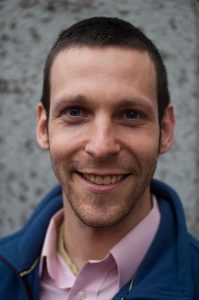
In this blog post I am delighted to share a recent conversation I had with Ethan Roland Soloviev (ERS). Ethan is an international expert on impact investing, permaculture, and regenerative entrepreneurship and agriculture. He is the co-author of Levels of Regenerative Agriculture and Regenerative Enterprise: Optimizing for Multi-Capital Abundance as well as a core developer of the 8 Forms of Capital framework (which I covered in a separate blog post).
Currently, Ethan is EVP of Research at HowGood, Inc, farmer at High Falls Farm, and publisher of a free monthly newsletter curating top stories in Regenerative Agriculture, Business, and Investing. He and his family farm a diversified 32 acres in New York, producing apples, sheep, mushrooms, eggs, and specialty crops.
I hope you find this interview between me (R&RL) and Ethan (ERS) as informative and thought-provoking as I did.
Regenerative Investing and Financial Independence
R&RL:
I started this blog to crowdsource information about how to pursue financial independence in a way that equally values people, planet, and profit. The majority of people currently on the path to FI set up automatic transfers into accounts in which they own low-cost broad-based index funds, which are a type of mutual fund that is considered a lower risk option with low operating expenses. This means that their money has been used to purchase stock shares in companies such as Coca-Cola, JP Morgan Chase, Exxon Mobil, and so many other enterprises that push unhealthy products, damage the environment, and use predatory or otherwise unsavory practices.
I consider every dollar I spend a very powerful vote for (and against) something. The same holds true with each dollar I invest. I’ve chosen to explore a less traditional FIRE (financial independence/retire early) journey by eschewing mainstream broad-based index funds and would like to invest my money in companies, enterprises, and projects that emphasize a more regenerative vs. extractive business model. I’ve transferred the majority of my retirement savings into a self-directed IRA, which allows me to invest my retirement funds in a wide variety of alternatives.
ERS:
It’s great that you are thinking this way and doing the work to pull this information together for other people who are working along these same lines. I look forward to you and others continuing to figure out better and better ways to achieve financial freedom without supporting an extractive economy. It’s very clear from what we’re seeing in the world right now that older ways of doing things will not necessarily last and will not provide the stability that our parents’ and grandparents’ generation experienced. It’s time to find different ways to do things. Fortunately, there are many people working in this arena. Unfortunately, we’ve got miles to go to get to viable, easily accessible solutions.
Levels of Regenerative Investing
R&RL:
You are very involved in regenerative agriculture and regenerative enterprises. What does the word regenerative imply? And what differentiates a sustainable enterprise, farm, or investment from a regenerative enterprise, farm, or investment?
ERS:
The easiest way to frame this is to think about different levels or ways of engaging with the world. These are paradigms that can be active in all of us. Over time people may work from multiple levels, seeing and experiencing different ways of engaging the world through the different paradigms.
To understand what is regenerative it can be helpful to contrast it with most everything else, because most everything else isn’t regenerative. The first paradigm to look at would be one that seeks to extract value. Let’s use agriculture as our example here. Currently, on a conventional farm, which is the majority of farms in this country, the primary emphasis is on extracting value, for example, “how many bushels of corn can we push out of this acreage?” “What can we add to the soil so that we can get a higher physical return and therefore a higher financial return per acre?”

The next paradigm or level is one that you could call reduce harm. People open their eyes to this paradigm when they begin realizing that prioritizing the extraction of value all the time actually strips the asset base, eliminating natural capital and negatively impacting the health and well-being of people, animals, and the planet. They recognize that just extracting value out of a natural resource for our own ends has a detrimental effect on whatever we’re extracting it from. At this level, the farmer wants to reduce the farm’s negative environmental impact and any suffering that the pesticides and other chemicals might cause others who eat the foods they grow.
So this is where the farmer tries to get more efficient. She uses much less chemical fertilizer, and fewer chemical pesticides and fungicides. She reduces the amount of water the farm uses. This is what most “sustainable agriculture” is, especially as it’s practiced by some of the larger agribusiness interests. They’re trying to do less harm, but it’s not really ending harm. The practices are not truly sustainable – It’s just doing less bad.
Most of what gets portrayed out there as being “more sustainable” is not actually sustainable. I remember seeing an advertisement for this “sustainable” water bottle. It contained 20% less plastic than the previous version because the manufacturer started making it with a smaller top. That’s really nice feel-good greenwash marketing for a product, but that product is not at all “sustainable”. The bottle simply contains 20% less plastic.
This pattern repeats over and over again. A great deal of socially responsible investing (SRI) or ESG* investing is similar – it’s trying to do less bad with the companies that we invest in. For example, Coca-Cola is a very highly rated SRI and ESG investment that still is engaged heavily in sugar production and the wholesale creation of diabetes around the world. They may be trying to do less bad by using fewer resources. But they are still simply working from a paradigm of “reduce harm”.
The next level past reduce harm might be called do good. This is where a farmer realizes she doesn’t just want to do less bad. She actually wants to do good by adding value to the farm that she’s working on. She wants to go beyond stopping depleting the soil of minerals and nutrients – she wants to actually build better, healthier soil. She sees the value of treating the farmworkers well, improving their quality of life, and providing the right livelihood for them and herself.
There is a good deal of activity at this level. We see this in the number of new SRI offerings each year as well as the B Corp movement globally. B Corporations legally require that the businesses consider the impact of their decisions on their workers, customers, suppliers, community, and the environment.
All of these aspire to do good. We hear phrases such as “do well by doing good .” That’s great. The enterprises operating at this level are qualitatively different and quantitatively doing less harm. But it’s still not regenerative.
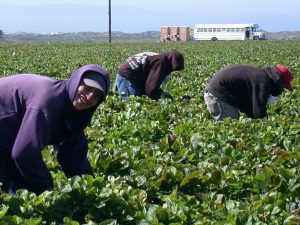
And the fourth level, which is closest to what we would describe as regenerative, could also be referred to as evolve capacity. This means that the farmer is not just doing good by building the soil on the farm, she’s actually evolving the capacity of the human beings and ecosystems in the bioregion to increase their viability, vitality, and ability to generate new potential. In the evolve capacity paradigm, the work of farming, or investing continuously develops whole human beings and the systems to which they contribute.
Regeneration touches, not just the single place where you’re farming or working but it aims to change the system that that place is part of. I farm here in the Hudson River Valley in New York, in aiming towards regenerative agriculture, I’m striving not just to build the soil on my farm but to grow the capacity of other people and farmers in this region to build the soil on their farms and affect the communities and larger systems of which they’re part.
It’s important to note that one level is not better than the others, but instead that each of them holds a different level of complexity and potential that can be generated. I admit that I sometimes fall into the trap of thinking that “evolve capacity” is “better”, but I work hard to not see it that way.
Regenerative Practices Evolve Capacity
R&RL:
I have done some pretty surface-level reading on regenerative agriculture and regenerative entrepreneurship, including your book Regenerative Enterprise, but I hadn’t yet picked up on the paradigm you described as evolve capacity. I wasn’t making the connection that when something is regenerative it goes beyond merely improving itself and actually has ripple effects beyond itself strengthening the entire ecosystem. So that’s a great thing for me to add to my understanding of it all.
ERS:
When I wrote that book five years ago I wasn’t clear about the differences either. Most people are not – the word ‘regenerative’ is often misused. Most of what you read about “regenerative” agriculture isn’t really regenerative. Instead, it’s about practices that come from the do-good or reduce harm paradigms. But people are calling what they’re doing “regenerative”. And so we’re seeing the rapid greenwashing of the word regenerative. Everybody wants to be seen as doing it, but it turns out, it’s hard! It takes a significant shift in our mind, our capabilities, and our practices to actually regenerate whole living systems. So people are just using the word but not really doing it – In agriculture, in business, and beyond.
Anyone interested in the book, Regenerative Enterprise, can download it online. It’s by donation so if you want to pay nothing, that’s fine and if you want to give us $1,000 for the book (which someone did!) that’s fine too. In the five years since we released the book, a good bit has changed and we’ve fine-tuned our thinking around the word regenerative significantly. There’s a blog post I wrote when we released the book in four different languages (Spanish, Italian, French, and Portuguese) where I summarized what’s changed since the book’s initial publication.
What is Your Money Supporting?
R&RL:
Some people reading this may find this idea appealing, but be new to this way of thinking, spending, and investing. How can people ease themselves away from index fund investing, which they consider safer and quite profitable in the current bull economy, into considering these more environmentally and socially conscious investing options, which may produce a (s)lower financial return?
ERS:
SRI mutual funds and other more traditional equity investing instruments that are available through a growing number of investment management firms are probably the most common “gateway” investment choices for those looking to divest from industries not aligned with their values. However, as you noted in an earlier blog post, many of these SRI funds are presented as “greener” or “more ethical” options than they actually are. They consist primarily of stocks of some of the same companies represented in mainstream index funds. It’s very disappointing.
I would also encourage your readers to consider viewing what they spend their money on (what businesses, products, and services you choose to support) as an investment that can impact their community and quality of life. We could look at this from a number of angles including health care and technology, but let’s focus on food.
Making more thoughtful food purchases is the easiest place for most people to start. Besides having a potentially positive impact on the environment, shifting one’s food purchasing is the most impactful change that people can make as it relates to the nexus between food and their own health.

Beginning with food and making radically different and better food choices is a wonderful and effective way to start the shift because it involves actually talking with your local farmers, listening, and hearing what they’re facing. It’s important that non-farmers learn what challenges face the remaining two percent of the US population that continue to farm and feed the rest of us. That process alone can be a fascinating wake-up call.
If you want a quick and easy way to start making changes in your purchasing, I recommend checking out the company I work for – HowGood. We rate food, health and beauty, and cleaning products from an ecological and social impact perspective. Our rating scale at HowGood is a simple app that you can download on your smartphone allowing you to scan the barcodes of products to get an overall sustainability rating for them, which is very useful if you’re trying to change how you eat and what you support.
Towards Regenerative Investing
R&RL:
All right, so for those of us with some money to invest, who would like to direct it to those level three and four enterprises you described, how would you suggest we go about this?
ERS:
Before we proceed let me point out that I am not a licensed financial advisor. Everyone reading this should do their own due diligence before making any investments. Don’t take my advice on anything I’m about to share. Test it with your own thinking.
There are almost no public equities that are truly aiming for regeneration even if they say they are. The only publicly traded companies that I’ve seen saying they’re aiming to do regenerative agriculture in some shape or form are General Mills through their brand Annie’s Organics, Danone, and Unilever which has focused a lot on sustainability. I think there will be more in five or ten years, and hopefully, the on-the-ground effects of these companies’ work will have caught up with their marketing.
It’s difficult to identify public equities that even reach the do good paradigm. Each year when the time comes for me to rebalance my asset allocations I am hopeful that I’ll find a plethora of new mutual funds or green bond funds that are really doing good, but I just haven’t found anything that impressive. For the most part, the best I can find are some companies that are aiming to do less bad and maybe a bit of good here and there.
I keep looking for individual stocks, which is a much riskier way to invest your money, but a more targeted way to do it in terms of matching your investments with your values. I think it’s possible to develop a sort of personal mini mutual fund that doesn’t contain stocks of greenwashed companies that really aren’t good for the world. It would focus on a handful of publicly traded companies that at least have the potential to connect to local ecosystems and do better for the world.

One of the resources I’ve used was created by a company called Natural Investments, which is a U.S.-based investment advisory firm specializing in SRI and impact investing. They created the Heart Rating System, back in 1992. It was developed by professionals who spend all day every day enmeshed in this world and provides a ranked snapshot of socially responsible investment mutual funds on environmental, social, and governance performance. I found this to be a helpful tool when whittling down the choices among the large number of mutual fund options out there that can be included in many IRA investment portfolios. So, that can be a good place for people to start.
There’s also a resource that Bloomberg produced in collaboration with the Social Investment Forum. It’s a pretty comprehensive matrix of mutual funds that contains a wealth of information that I found useful in choosing better mutual funds to invest in.
I am very interested in green bonds because I think green bonds, especially if they’re more localized, such as municipal bonds offer greater opportunities to invest money locally. There are firms bundling up municipal bonds from a variety of different places and offering them as a fund. This means that there are a few bond funds out there that are decent for a fixed income type of return.
If somebody wants to choose an investment advisor Natural Investments can be a great place to start. (I don’t get any money from them for saying this – There’s no financial connection between us.) Finding an investment advisor that can help guide you in these things is great, especially if you have significant enough amount of financial capital while still not being an accredited investor. Another option is Paul Herman’s company HIP Investor (human impacts + profits). I enjoyed his book The HIP Investor: Make Bigger Profits by Building a Better World. That said, a lot of what he argues for is still more along the lines of reduce harm with some do good in there.
R&RL:
Can we go back to the green bonds you talked about for a moment? Are the green bond investing opportunities that exists something you can learn about from the natural investments rating system or some other source? How does a beginning investor learn about those?**
ERS:
I would start by looking into bond funds and look to ESG or SRI bond funds, of which there are many fewer than the straight equity funds, but they exist. I would read up on those and then see what they are. The process for investing directly in municipal bonds is more complex than I have tackled on my own. I don’t know that there’s a clear easy way to invest in green bonds at the local level yet, which is why I look to managed funds that look for those opportunities systemically.
Regenerative Investing for Non-accredited Investors
R&RL:
At this point in my life, I am still a non-accredited investor, a Securities and Exchange Commission (SEC) designation which means my net worth is less than $1 million and my annual salary is less than $200,000. Are you aware of any additional options for non-accredited investors interested in investing their money in socially and environmentally conscious ways?
ERS:
Title III of the JOBS Act, which went into effect under President Obama, established crowdfunding provisions that allow early-stage businesses to offer and sell securities. Many of these securities offerings are available to non-accredited investors. There are more and more crowdfunding platforms showing up all the time.
R&RL:
Yes, such as SeedInvest, Investibule, and Wefunder. I’ve made a number of small investments through these platforms in sustainably minded or socially conscious startups, including most recently a hydroponic hops farm in my hometown.
ERS:
Yes, so those are good options for relatively low amounts of money that can be invested in startups, and you’re actually investing without having to be an accredited investor.
And another investment vehicle that I think is underutilized is making personal loans to local businesses. These can be especially useful for local food and agriculture businesses, who often need financing for things like expanding their production, replacing or purchasing new equipment, or building a value-added processing line. You won’t own a portion of their company by loaning them money, but you can learn a lot about entrepreneurship and agriculture, and start building your skills for conducting due diligence towards the level at which it’s being conducted by accredited investors on more complex equity deals.
That way when your readers become accredited investors, (which I hope they all do:), they’ll be able to really start doing some more interesting private equity investing. They can gain significant experience as they move towards that goal by loaning small amounts – perhaps between $1,000 and $10,000 – to a local farm, food business, or beauty company working to grow. You can learn a lot about specific businesses in this way. It’s fun and risky and you might lose your money. But the point isn’t really to make huge returns. The point is to learn how you can be an effective investor as you grow the financial capital that you have access to.
A Side Note about Regenerative Agriculture
R&RL:
In a recent interview with the team at Regeneration International you made the point that a large gap currently exists between the big ideas and enthusiasm for regenerative agricultural enterprises and a lack of reality about how to turn these ideas into profitable businesses. While this is a slight tangent from the main topic of our discussion, I think it is worth noting that for anyone reading this, who is considering pursuing a career in regenerative agriculture that a lot of opportunity exists in this space for knowledgeable, experienced, hard-working farmers, growers, etc. to make a living and secure capital. Your interview with the Regeneration International team is full of helpful content for anyone interested in learning more.
ERS:
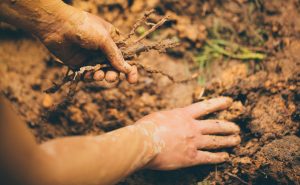
Yes, the regenerative agriculture movement needs people who have a depth of knowledge in what they’re doing. We need people who have (or want to develop) experience growing successful businesses. And, more importantly, we need people who can farm holistically. People who can manage intensive rotational grazing operations with multiple species on multiple pieces of land, who can successfully regenerate soil and produce food. We also need people who want to grow fruit trees and nut trees – perennial crops have been proven profitable over and over again and in general, they are our best bet for rapid carbon sequestration. Next, the two approaches must be integrated combining tree crops with livestock production – this is where it starts to get fun, and extremely effective.
There are many things that can be done to create agricultural enterprises that can be invested in. I think that working with the current investing system, especially with the crowdfunding innovations we discussed, will be the fastest route to grow a new regenerative agriculture industry.
R&RL:
How do you suggest people get started investing and lending in this arena? It’s one thing to want to make these types of loans, but how do people go out and actually make those connections and find viable businesses to lend to?
Slow Money Chapters
ERS:
There are a couple of approaches that I would recommend. One is to start at your local farmers market and meet every farmer you can and learn as much as you can about them – what their challenges are, what they’re looking for, how they’re hoping to grow their business or not. The second is to look for a local Slow Money chapter. Slow Money is an international organization that’s aiming to encourage and facilitate local investing in food. Attending one of the National Slow Money events is a great thing to do.
Another thing you can do is contact either your local community development organization or even the chamber of commerce or the small business development organization and just start talking to people. Say, “Hey, I’m interested in meeting some local entrepreneurs. I have a bit of excess capital – like $1,000, $5,000, or $10,000 – and I’d be interested in meeting and helping out local businesses.” Just see who’s out there that needs money, but move slow. There’s no rush to do this. You’ll be learning about the businesses as you go. You’ll learn about the types of terms and opportunities that are out there and you just grow and increase your lending and investing activity as you can.
R&RL:
That sounds like very good advice. And I will just add also that I think Slow Money is great. There are a number of active chapters I’m aware of in the San Francisco Bay area, in North Carolina, and Maine. I’m sure there are others, but those are the ones with which I’m most familiar. And Slow Money would also love to have people come together and create new chapters if they live in an area where there isn’t a chapter already. In fact, we’re working to establish one here in St. Petersburg, FL, where I live, or something along the lines of the Local Investing Opportunities Network (LION) in Washington state.
Additional Regenerative Investing Resources
R&RL:
Are there other organizations we haven’t mentioned or websites or books or resources you would recommend for non-accredited investors that are wanting to invest more and learn or think more about regenerative agriculture and businesses?
ERS:
Well, I publish a free monthly newsletter called Regeneration Newsroom where I curate the major news pertaining to regeneration. This last month focused on regenerative agriculture, with a little bit on regenerative investing. That’s totally free and an easy way to start reading about and seeing what’s happening out there. I also give some very opinionated commentary in this newsletter on whether things that are billed as regenerative really are. Or are they just saying they are but aren’t actually acting like it? So that’s one resource.
There’s a podcast that I very much appreciate called Investing in Regenerative Agriculture. I’ve been interviewed there, along with over 40 people from many sides of the industry. A few months ago the host Koen van Seijen and I are starting to collaborate on a new project, where we discuss the news in my monthly newsletter. It’s like CNN news, for regeneration!

If you want to dig more into regenerative business and think outside of just farming, there are so many books I’d recommend! Here’s a few to get you started: 1. my book Regenerative Enterprise, 2 The Responsible Entrepreneur by Carol Sanford and 3. The Regenerative Business by Carol Sanford. She is probably the most influential force in regeneration right now, and has been for nearly 40 years. You can also read her writings on her websites — Carolsanford.com and Carolsanfordinstitute.com. There are many videos as well, which I highly recommend – she offers the deepest perspective on regeneration that’s out there.
There are so many great books to read! Rather than talking through them here, I’ll just say that on my website, I did something that was really fun and I had been wanting to do for years. I made a list of the most influential books in my life, the ones that really changed something for me — starting from when I was a kid all the way up until now. For some of them I’ve written brief descriptions of why it changed my life. Check it out and let me know what you think!
R&RL:
Are there any conferences or other events that you would encourage people to consider attending to learn more about sustainable and regenerative investing?
ERS:
There’s a conference coming up 2019 called Transform:Land. It’s focused on regenerative agriculture, partially in the food system. That’s a great place to meet others and hear about regenerative enterprises. Attending the SoCap conference, which is focused on Social Capital takes place in California every year is another good option.
Regeneration Canada is putting on a summit. Last year it drew people from all over the world. So that is another event that I’d recommend in terms of getting into regenerative agriculture.
On a local scale you want to seek out your closest Slow Money chapter or local lending club and see what events they have scheduled. Also, a good way if you want to dig into agriculture is just to find your local organic farming organization. Most states have one. Going to their conference is an excellent way to get to know people and see what’s happening in the local agricultural community.
R&RL:
This pioneering work you and others are doing on regenerative practices in agriculture, business, and investing is so important, Ethan. Thank you very much for taking the time to share your knowledge with me and my readers.
*Environmental, Social and Governance (ESG) criteria are a set of standards for a company’s operations that socially conscious investors use to screen potential investments. – Investopedia
**After concluding this interview with Ethan I found a number of helpful articles online about green bond offerings, including this one.
***Since interviewing Ethan I wrote this post about the more sustainable and regenerative investments I’ve made to date.
What about you?
Have you made any investments in businesses or other practices that strive to reduce harm or evolve capacity?
If you find value in the content here at Rich & Resilient Living, please consider supporting my work by ‘buying me a cup of tea’ using the Ko-fi button just below and then selecting the red support button on the right hand side of my Ko-fi page. Thank you very much indeed.

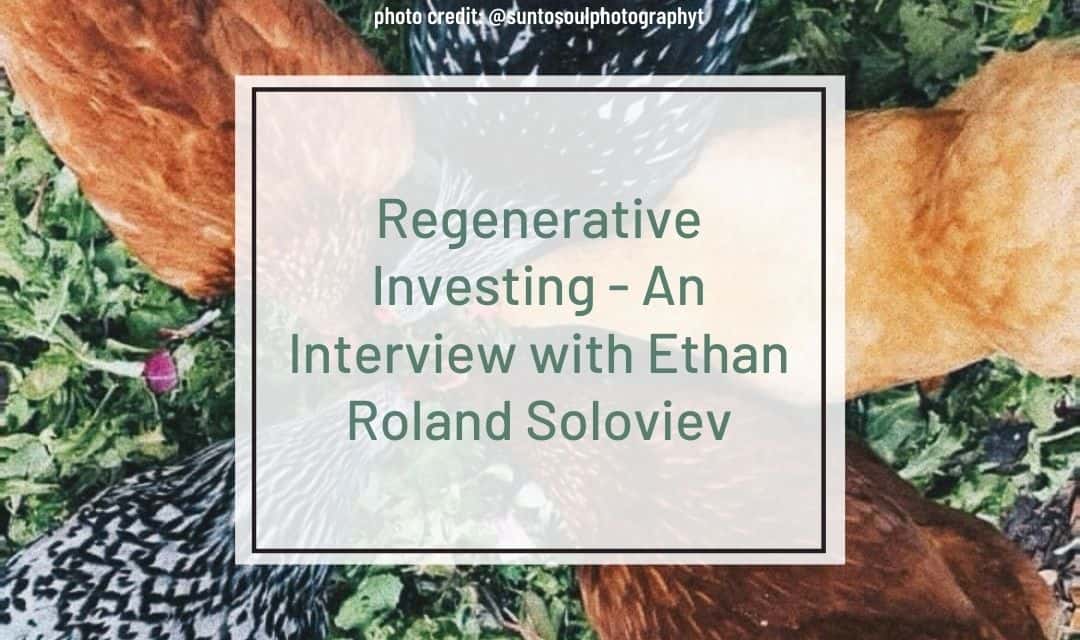
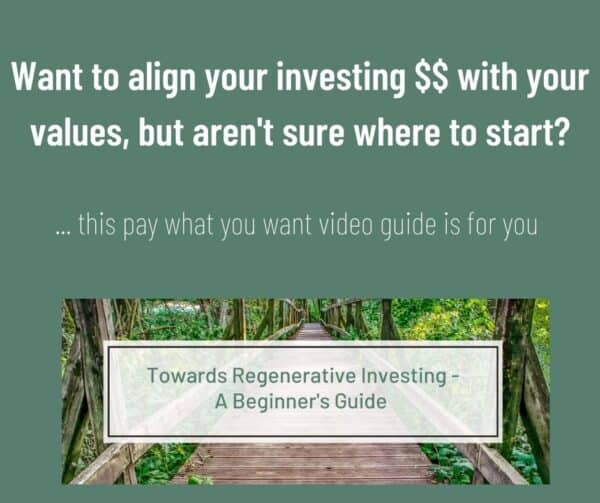

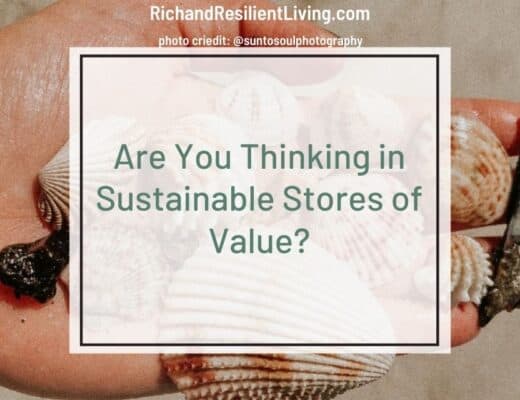
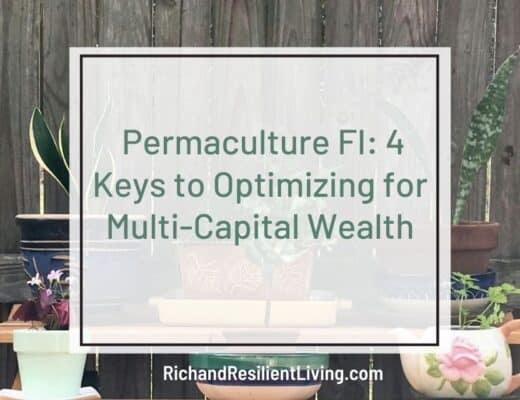

7 Comments
10 Awesome Sustainable Frugal Bloggers To Follow - Frugasaurus
February 7, 2019 at 5:29 am[…] about! Her dumpster diving skills are enviable, and her focus on making sure her investments are ethically sound is beyond admirable. She also wrote the first ever guest post over at Your Money or Your Life, […]
The Resilient Investor Map (RIM): A Helpful Tool for a More Resilient FI - Triple Bottom Line FI
March 29, 2019 at 5:35 am[…] Some readers may already be familiar with Natural Investments because one of their clients is Vicki Robin co-author of Your Money or Your Life, a widely read book in FI/RE circles. She has mentioned her involvement with them in a number of online settings as well as in the updated 2018 version of the book. Other readers may know of them as the originators of The Heart Rating, which evaluates the environmental, social, and governance performance of mutual funds and was referenced by Ethan Roland in my interview with him on regenerative investing. […]
Financial Permaculture: Making Financial Independence (FI) More Meaningful & Resilient - Triple Bottom Line FI
August 18, 2019 at 1:43 pm[…] 3pfi Investing resources page. I also shared a number of related investing ideas in my blog post on regenerative investing as well as part one and two of my series on the global warming solutions presented in the book […]
How I am Investing to Save the Planet - Triple Bottom Line FI
January 6, 2020 at 10:15 am[…] traditional mutual funds, even the socially responsible ones. Below is a chart I created based on my interview with Ethan Roland of How Good, Inc. in which we discussed regenerative investing. I’ll use these levels of regenerative […]
Welcome to Your Guide to a Rich & Resilient Life - Rich and Resilient Living
April 14, 2020 at 2:53 pm[…] of capitals as well. As Ethan Roland Soloviev, co-author of Levels of Regenerative Agriculture whom I interviewed previously about regenerative investing, has noted we want to “optimize for multi-capital […]
How I am Investing to Save the Planet - Rich and Resilient Living
June 1, 2020 at 6:23 pm[…] traditional mutual funds, even the socially responsible ones. Below is a chart I created based on my interview with Ethan Roland of How Good, Inc. in which we discussed regenerative investing. I’ll use these levels of regenerative […]
Permaculture & Money - Rich and Resilient Living
May 27, 2022 at 9:14 am[…] my interview with Ethan […]